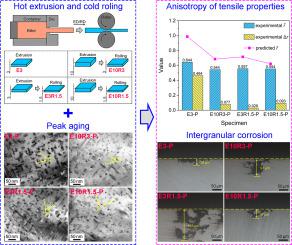当前位置:
X-MOL 学术
›
Mater. Charact.
›
论文详情
Our official English website, www.x-mol.net, welcomes your
feedback! (Note: you will need to create a separate account there.)
Microstructure evolution, plastic anisotropy, and intergranular corrosion of Al-Mg-Si sheet processed through a combination of hot extrusion and cold rolling
Materials Characterization ( IF 4.8 ) Pub Date : 2020-06-01 , DOI: 10.1016/j.matchar.2020.110299 Zhigang Li , Liang Chen , Jianwei Tang , Guoqun Zhao , Cunsheng Zhang , Xingrong Chu
Materials Characterization ( IF 4.8 ) Pub Date : 2020-06-01 , DOI: 10.1016/j.matchar.2020.110299 Zhigang Li , Liang Chen , Jianwei Tang , Guoqun Zhao , Cunsheng Zhang , Xingrong Chu

|
Abstract Peak-aged Al-Mg-Si alloys fabricated through a combination of hot extrusion and cold rolling were studied, and the microstructure evolution, mechanical properties, plastic anisotropy, and intergranular corrosion (IGC) were clarified. The results show that fully dynamic recrystallization and grain growth occurred during the hot extrusion, resulting in a coarse and equiaxed grain structure. The cold rolling caused an elongation of the coarse grains and the formation of some fine grains. After solution and aging, the as-extruded grains were unchanged, whereas the as-rolled specimens exhibited a finer grain structure with a large amount of high-angle grain boundaries owing to the occurrence of static recrystallization. All as-extruded/rolled specimens mainly showed a cube and Goss texture. In the peak-aged state, the deformation textures of the rolled specimens decreased to a low level, whereas the fraction of Q and R significantly increased. A fine high-density needle-like β″ phase was uniformly distributed in all aged specimens. If the thickness of the peak-aged Al-Mg-Si sheet is uniform, the combination of hot extrusion and cold rolling, or an increase in the rolling reduction, can enhance the tensile strength and elongation. Although the combined process enhanced the plastic anisotropy, the variation in the r-values along the different directions was decreased. The IGC resistance of the Al sheet experienced hot extrusion and cold rolling, and the peak aging was slightly reduced owing to a high fraction of high-angle grain boundaries.
中文翻译:

热挤压冷轧相结合加工的Al-Mg-Si薄板组织演变、塑性各向异性及晶间腐蚀
摘要 研究了热挤压和冷轧相结合制备的峰时效Al-Mg-Si合金,阐明了其显微组织演变、力学性能、塑性各向异性和晶间腐蚀(IGC)。结果表明,在热挤压过程中发生了充分的动态再结晶和晶粒长大,形成了粗大的等轴晶粒结构。冷轧导致粗晶粒的伸长和一些细晶粒的形成。固溶和时效后,挤压态晶粒没有变化,而轧态试样由于发生静态再结晶而呈现出更细的晶粒结构和大量的大角度晶界。所有挤压/轧制样品主要显示立方体和高斯纹理。在巅峰时期,轧制试样的变形织构降低到较低水平,而 Q 和 R 的分数显着增加。细高密度针状β″相均匀分布在所有老化试样中。如果峰时效Al-Mg-Si板的厚度均匀,热挤压和冷轧相结合,或增加压下率,可以提高抗拉强度和延伸率。虽然组合过程增强了塑性各向异性,但沿不同方向的 r 值的变化减小了。铝板的抗IGC性能经过热挤压和冷轧,由于高角度晶界比例高,峰值时效略有降低。细高密度针状β″相均匀分布在所有老化试样中。如果峰时效Al-Mg-Si板的厚度均匀,热挤压和冷轧相结合,或增加压下率,可以提高抗拉强度和延伸率。虽然组合过程增强了塑性各向异性,但沿不同方向的 r 值的变化减小了。铝板的抗IGC性能经过热挤压和冷轧,由于高角度晶界比例高,峰值时效略有降低。细高密度针状β″相均匀分布在所有老化试样中。如果峰时效Al-Mg-Si板的厚度均匀,热挤压和冷轧相结合,或增加压下率,可以提高抗拉强度和延伸率。虽然组合过程增强了塑性各向异性,但沿不同方向的 r 值的变化减小了。铝板的抗IGC性能经过热挤压和冷轧,由于高角度晶界比例高,峰值时效略有降低。可提高抗拉强度和伸长率。虽然组合过程增强了塑性各向异性,但沿不同方向的 r 值的变化减小了。铝板的抗IGC性能经过热挤压和冷轧,由于高角度晶界比例高,峰值时效略有降低。可提高抗拉强度和伸长率。虽然组合过程增强了塑性各向异性,但沿不同方向的 r 值的变化减小了。铝板的抗IGC性能经过热挤压和冷轧,由于高角度晶界比例高,峰值时效略有降低。
更新日期:2020-06-01
中文翻译:

热挤压冷轧相结合加工的Al-Mg-Si薄板组织演变、塑性各向异性及晶间腐蚀
摘要 研究了热挤压和冷轧相结合制备的峰时效Al-Mg-Si合金,阐明了其显微组织演变、力学性能、塑性各向异性和晶间腐蚀(IGC)。结果表明,在热挤压过程中发生了充分的动态再结晶和晶粒长大,形成了粗大的等轴晶粒结构。冷轧导致粗晶粒的伸长和一些细晶粒的形成。固溶和时效后,挤压态晶粒没有变化,而轧态试样由于发生静态再结晶而呈现出更细的晶粒结构和大量的大角度晶界。所有挤压/轧制样品主要显示立方体和高斯纹理。在巅峰时期,轧制试样的变形织构降低到较低水平,而 Q 和 R 的分数显着增加。细高密度针状β″相均匀分布在所有老化试样中。如果峰时效Al-Mg-Si板的厚度均匀,热挤压和冷轧相结合,或增加压下率,可以提高抗拉强度和延伸率。虽然组合过程增强了塑性各向异性,但沿不同方向的 r 值的变化减小了。铝板的抗IGC性能经过热挤压和冷轧,由于高角度晶界比例高,峰值时效略有降低。细高密度针状β″相均匀分布在所有老化试样中。如果峰时效Al-Mg-Si板的厚度均匀,热挤压和冷轧相结合,或增加压下率,可以提高抗拉强度和延伸率。虽然组合过程增强了塑性各向异性,但沿不同方向的 r 值的变化减小了。铝板的抗IGC性能经过热挤压和冷轧,由于高角度晶界比例高,峰值时效略有降低。细高密度针状β″相均匀分布在所有老化试样中。如果峰时效Al-Mg-Si板的厚度均匀,热挤压和冷轧相结合,或增加压下率,可以提高抗拉强度和延伸率。虽然组合过程增强了塑性各向异性,但沿不同方向的 r 值的变化减小了。铝板的抗IGC性能经过热挤压和冷轧,由于高角度晶界比例高,峰值时效略有降低。可提高抗拉强度和伸长率。虽然组合过程增强了塑性各向异性,但沿不同方向的 r 值的变化减小了。铝板的抗IGC性能经过热挤压和冷轧,由于高角度晶界比例高,峰值时效略有降低。可提高抗拉强度和伸长率。虽然组合过程增强了塑性各向异性,但沿不同方向的 r 值的变化减小了。铝板的抗IGC性能经过热挤压和冷轧,由于高角度晶界比例高,峰值时效略有降低。











































 京公网安备 11010802027423号
京公网安备 11010802027423号